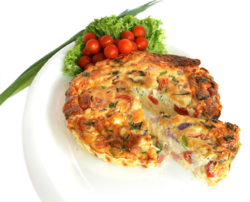Frittata
 | |
| Type | Omelette |
|---|---|
| Place of origin | |
| Main ingredients | Fried beaten eggs |
| Variations | Fritaja (Istria) |
Frittata is an egg-based Italian dish similar to an omelette or crustless quiche or scrambled eggs, enriched with additional ingredients such as meats, cheeses, or vegetables. The word frittata is Italian and roughly translates to "fried".
History[]
The Italian word frittata derives from friggere and roughly means "fried". This was originally a general term for cooking eggs in a skillet, anywhere on the spectrum from fried egg, through conventional omelette, to an Italian version of the Spanish omelette, made with fried potato. Outside Italy, frittata was seen as equivalent to "omelette" until at least the mid-1950s.[1]
Frittata has come to be a term for a distinct variation that Delia Smith describes as "Italy's version of an open-face omelette".[2] When used in this sense, there are four key differences from a conventional omelette:
- There is always[citation needed] at least one optional ingredient[further explanation needed], the most popular being cubed potato,[3] and such ingredients are combined with the beaten egg mixture while the eggs are still raw[4][5] rather than being laid over the mostly cooked egg mixture before it is folded, as in an omelette.[6]
- Eggs may be beaten vigorously, to incorporate more air than traditional savory omelettes, to allow a deeper filling and a fluffier result.
- The mixture is cooked over a very low heat, more slowly than an omelette, for at least five minutes,[5] typically 15, until the underside is set but the top is still runny.[2][7]
- The partly cooked frittata is not folded to enclose its contents, like an omelette, but is instead either turned over in full,[4][7][8] or grilled briefly under an intense salamander to set the top layer,[2][5][7] or baked for around five minutes.[9]
See also[]
- Eggah – Arab egg dish of eggs cooked in a pancake, with vegetable or meat and spices (a similar Arab egg dish)
- Kuku (a similar Persian egg dish)
- Okonomiyaki – Japanese savory pancake
- Spanish omelette – Traditional Spanish dish of egg and potato (a similar Spanish dish)
- Tunisian tajine – Berber dish (a similar Tunisian egg dish)
- List of brunch foods – Wikipedia list article
- List of egg dishes – Wikipedia list article
References[]
- ^ Elizabeth David (1954). Italian Food. Barrie & Jenkins (published April 5, 1990). ISBN 978-0-7126-2000-0.
- ^ Jump up to: a b c Delia Smith (1998). Delia's How To Cook. Book One. BBC Worldwide. pp. 48–49. ISBN 0-563-38430-1.
the Italian word here is lentamente—very slowly
- ^ Andrea Soranidis (2017). Classic Italian Potato Frittata recipe.
- ^ Jump up to: a b Robert Carrier (1963). Great Dishes of the World. Sphere Books (published 1967). p. 121. ISBN 0-7221-2172-5.
- ^ Jump up to: a b c Sarah Brown (1984). Vegetarian Cookbook. HarperCollins. p. 127. ISBN 0-7225-2694-6.
- ^ H L Cracknell and R J Kaufmann (1972). Practical Professional Cookery. Macmillan (published 1973). pp. 114–119. ISBN 0-333-11588-0.CS1 maint: uses authors parameter (link)
- ^ Jump up to: a b c Nigel Slater (1992). Real Fast Food. Penguin Books (published 2006). pp. 39–40. ISBN 978-0-14-102950-4.
- ^ Gillian Riley (1 November 2007). "Eggs". The Oxford Companion to Italian Food. Oxford University Press. p. 168.
- ^ Jamie Oliver. "roasted chilli frittata". Jamie magazine issue 7. Archived from the original on 2011-02-20.
External links[]
| Look up frittata in Wiktionary, the free dictionary. |
- Egg dishes
- Omelettes
- Italian cuisine
